Punjab State Board PSEB 10th Class Physical Education Book Solutions Chapter 3 Yoga Textbook Exercise Questions and Answers.
PSEB Solutions for Class 10 Physical Education Chapter 3 Yoga
Very Short Answer Type Questions
Question 1.
Which is the oldest method of Indian exercises?
Answer:
Yoga Asana.
![]()
Question 2.
How much time Search Asana may be performed daily?
Answer:
2 minutes only
Question 3.
Name the Asana which prevents Hernia and Urinary diseases.
Answer:
Chabar Asana.
Question 4.
Mention any two advantages of Searsh Asana.
Answer:
- Increase the learning power.
- Remove the fat of the body.
Question 5.
Mention any two advantages of Vazur Asana.
Answer:
- It cures night fall.
- It also cures diabetes.
Question 6.
Mention any two advantages of Padam Asana.
Answer:
- Cure the pain of waist.
- Passing of urine become normal.
Question 7.
Describe any two advantages of Bhujang Asana.
Answer:
- Remove constipation.
- Albumin disease is cured.
Question 8.
Mention any two advantages of Dhanur Asana.
Answer:
- Arthritis is cured.
- Menstruation and Venereal diseases of women are cured.
Question 9.
Which is the means of uniting soul with God?
Answer:
Yoga.
PSEB 10th Class Physical Education Book Chapter 3 Yoga
Question 10.
Which is the best Asana for mental concentration?
Answer:
Padam Asana.
![]()
Question 11.
How many types of Fatigue are there?
Answer:
Two types of fatigue:
- Mental
- Physical.
Short Answer Type Questions
Question 1.
“Yoga is the means of uniting soul with God.” How?
Answer:
Yoga can be defined as science of healthy and better living physically, mentally, intellectually and spiritually. Thus, Yoga is the union of soul with God. The medium of this sweet and happy union is body. The union of soul and God takes place by means of healthy and strong body, and we can have a vision of the Almighty God. Yoga makes body strong and healthy.
As such, it is the only means of the union of soul and God.
God is the embodiment of other-worldly qualities, actions and knowledge. He is all pervading like the sky. The mutual relation between the living being and God is a must. Yoga is helpful in strengthening’these bonds or connections.Man’s aim is to enjoy all the comforts of the world and to make the living soul one with God so that he may get rid of the cycles of births and rebirths and attain salvation.
Question 2.
Yoga is becoming very popular in foreign countries. Why?
Answer:
Yoga is an ancient knowledge of India. Yogic science is very important in human life. All over the world doctors and physical education teachers accept the importance of this ancient knowledge. Yoga Asana is a scientific knowledge and useful for persons of all ages. Yoga contributes in the complete development of man.
Question 3.
Write any five points which one should keep in mind while doing Asana.
Answer:
1. Yoga Asanas should be performed in the morning after the practitioner eases himself. It is better to perform Yoga Asanasafter having a bath. After taking bath body feels light and flexib and Asanas get performed very easily. Asanas can, of course, be don with empty stomach in the evening, too.
2. The place of Asanas should be clean and peaceful. It is desirable if Asanas are performed in a green park or garden.
3. The place where Asanas are to be performed should be even. Asanas should be performed on a mat so that one’s concentration is not disturbed by gravitational pull of the earth or by anything else.
4. One should not indulge in talks while performing Asanas. One should concentrate on one’s breathing and on the organ on which pressure is felt. The more one gets concentrated the more shall be the benefit of the Asanas performed. Perform Shavasana before doing other Asanas to make body, mind and breath calm and poised.
5. Yogic exercises are slow and non-aggressive. They should never be performed with jerks. Each Asana should be performed slowly by making the body alert and tense. Then the body should be kept in a relaxed state after some time. The second Asana should be performed when breathing becomes normal.
![]()
Question 4.
Describe tKe importance of Shav Asana.
Answer:
This asana should be performed for 3-5 minutes. It should be performed at the start and end of every asana.
Importance-
- Shavasana helps in getting rid of high blood pressure and mental tension.
- It keeps the heart and the brain fresh.
- It removes the fatigue in the body.
Question 5.
Describe the Advantages of Yoga Asana.
Answer:
- Man’s basic faculties of body and mind develop by means of Yoga. Lungs get enough air through the exercise of pranayama, as a result of which they get exercised and energised, and get rid of many ailments.
- Man’s body remains completely healthy through Yoga.’ Dhoti and Basti help in cleaning liver and intestines respectively. Clean body, we know, always remains healthy.
- Body gets strengthened with Yoga.
- By doing Yogic Asanas the organs of body become flexible. For example Hal-Asana and Dhanur-Asana help in increasing the flexibility of the backbone.
- All body systems begin to function properly with Yogic exercises.
- Yogic exercises keep human body in good and correct posture, as a result of which man’s personality improves. For example, by doing Brikh-Asana, knees do not strike, and by doing Padam-Asana, one’s belly does not protrude and shoulders do not develop hump.
- Mental discipline develops by doing Yoga. By doing Yama and
Niyama, one is enabled to exercise control on one’s undesirable emotions and vices. - Many ailments get removed by performing Yoga Asanas correctly. Vajar-Asana and Mastainder-Asana help in the removal of diabetes. Similarly, Pranayama keeps the lungs free from ailments.
- Yoga Asanas help in removing physical and mental fatigue. Shavasana helps in the removal of tiredness.
- Man’s intelligence and memory increase as a result of performing Yoga Asanas. Shirsh-Asana proves to be very useful in this respect.
- Yogic exercises develop a sort of rhythm in man’s body.
- Yogic Asanas are the best means of attaining peace and balance of mind.
Question. 6.
Describe the Technique of Shav Asana.
Answer:
Shav Asana:
In this asana, one lies down prostrate and loosens the body. In order to perform this asana, lie down straight on the ground over the back and loosen all the parts of the body completely. Gradually, breathe in deeply. The distance between the feet should be 1.5 ft.Keep the wrists of the hands away from the body, facing the sky. Close your eyes, introspect and think as if the body were getting loose. Feel that the body is in a position of rest.

![]()
Long Answer Type Questions
Question 1.
What is Yoga? What are the advantages of Yoga?
Answer:
‘Yoga can be defined as science of healthy and better living physically, mentally, intellectually and spiritually.” Thus, Yoga is the union of soul with God. The medium of this sweet and happy union is body. The union of soul and God takes place by means of healthy and strong body, and we can have a vision of the Almighty God. Yoga makes body strong and healthy. As such, it is the only means of the union of soul and God. God is the embodiment of other-wordly qualities, actions and knowledge. He is all-prevading like the sky. The mutual relation between the living being and God is a must. Yoga is helpful in strengthening these bonds or connections.
Advantages of Yoga:
- Prevention of Diseases.
- Corrective Values and Relaxation.
- Development of Strength.
- Development of Physical, Mental and Latent power of man.
- Emotional development.
- Internal cleanliness of body.
- Spirit of Sacrifice and Discipline.
Question 2.
“Yoga is the means of uniting soul with God.” How?
Answer:
Yogic science is very important in human life. Yoga is not only the ancient knowledge of India but of the whole world. All over the world doctors and Physical Education teachers accept the importance of this ancient knowledge. Through Yoga body and mind remain healthy and nerves also remain strong and flexible. Yoga keeps one away from all ailments, and in case one falls ill, Yoga helps him to cure through various exercises. Not only does it make one healthy, strong and energetic it also makes one’s personality attractive. In fact, it takes one to a world of supreme bliss, life, health, comfort and peace.
It is the river of that knowledge, the single drop of which is sufficient to cure an ailment. It is a great means of uniting one with God. Body is, thus, a medium of the meeting of soul and supreme soul (God). Through a healthy body one can visualize the Almighty God. Yoga makes one healthy and strong as also efficient and skilful. It infuses in us energy. It is useful not only for the patients but also for the healthy persons. Healthy persons can make best use of Yoga. Yoga is useful for persons of all ages.
Aim of Yoga:
The main aim of Yoga is to win over the mind by maintaining the body healthy, flexible, energetic and active and by developing Great Powers by which the soul may unite with the Supreme Soul (God). In fact, salvation (‘Mukti’) is getting rid of the cycles of births and deaths by uniting the soul with the Supreme Soul. Two forms of ’V Yoga Asanas and Pranayams are directly related to Physical Education. Through Yogic science, man merges into God by winning over the mind, keeping the body healthy, energetic and active, and disciplining conduct and behaviour.
![]()
Question. 3.
Describe the technique of any five Asana and explain their advantages.
Answer:
Shavasana:
Position: In Shavasana one lies down prostrate loosing the body-
- Technique. In order to do this asana lie down straight on the ground ones the back and loosen all the parts of body completely.
- Then breathe in deeply.
- Relax the whole body.
- Keep the distances of the feet of 1.5 ft.
- Keep the wrists away from the body facing the sky.
- Close your eyes, try to concentrate your mind.
Fact as of the whole body is getting loose and that the body is in the state of rest.

Advantages:
- Shavasana helps in geting rid of blood pressure and mental tension.
- It keeps the heart and the brain fresh.
- It removes physical fatigue.
Paschimottan Asana:
In it, one holds, the thumbs of the feet with fingers and sits in such a say that the trunk moves towards one side.

Position of Paschimottan Asana:
In doing this asana, the whole body is stretched and bent:
Technique of Paschimottan Asana-
- Spread both the legs forward.
- Sit on the ground. Hold the thumbs of the feet with both the hands.
- Breathe out slowly and try to touch the knees.
- Breathe in slowly. Raise the head upwards and return to the former position.
- Repeat this asana 10-15 times.
Advantages:
- It lends strength to the thighs.
- It helps cleanse the blood vessels.
- It helps in getting rid of the various diseases of the belly.
- It reduces the excess fat of the body.
- It helps in the removal of gas trouble.
Dhanur Asana:
In performing this asana one lies prostrate, pulls up the legs and holds*the knees with the help of hands.

Technique of Dhanurasana:
In this asana, the shape of the body is like that of a bow. In order to perform this asana, lie over the belly on the ground. Bend the knees backward. Hold the feet near the ankles with hands. Breathe in deeply and raise the chest upwards as much as possible. Now make the feet tense so that the body acquires the shape of a bow. Remain in the position as long as possible. Breathe out. Keep the body loose and go back to the former position. Repeat this asana 3-4 times. Shalabhasana and Dhanurasana should be done turn by turn.
Advantages:
- Dhanurasana reduces obesity.
- It increases digestive power.
- It helps in getting rid of rheumatism and urinary diseases.
- It makes the stomach and intestines strong.
- The vertebral column and muscles become strong and flexible with this asana.
Padam Asana:
In performing this Asana, one sits squatting.
Position of Padam Asana:
In this asana the position of the body is like that of lotus.
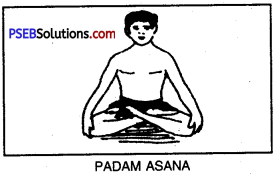
Technique of Padamasana-
After sitting in the squatting position, place the right foot on the left thigh in such a way that the heel of the right foot touches the hip bone of the left thigh. Then lift the left foot up, and in the same way place it on the right thigh of the right foot. The vertebral column should be perfectly straight. Stretch the arms on the knees. It becomes very easy to perform this asana after a few days’ practice.
Advantages:
- It increases the digestive power.
- It is very good for the concentration of the mind.
- It helps in getting rid of backache.
- It enables a person to escape from the diseases of the heart and belly.
- It helps in the removal of urinary troubles.
Halasan:
Position: In doing this asana one lies in the supine position.
- Technique. Raise both legs and keep the head away and lift both feet and bring both legs behind the head.
- Touch the thumb of your feet to the ground. .
- Maintain the position as you can.
- Bring your feet at the same place from where you have started to left.

Advantages:
- Hal Asana is very useful for every men and women of every age.
- It is the best asana for the person of heart disease or a person who is suffering from high or low blood pressure.
- It regulates the circulation of blood.
- Removes fat of the body slim the waste and belly.
- It provides flexibility to the backbone.
Sarvang Asana:
In this Asana, one stands on one’s shoulders.
Technique of Sarvang Asana: In this asana, the position of the body is like that of Ardh Hal Asana. For performing this asana, straighten the body and lie on the ground over the back. Place both the hands along the thighs. Lift both the feet once. Resting the back with the help of wrists, let the elbows rest on the ground. Keep the whole of your body straight. Let the weight of the body be on the shoulders and the neck. Let the chin touch the neck.
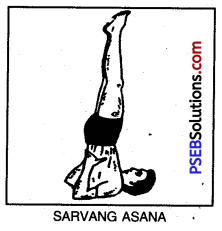
After remaining in this position for some time, return td the former position slowly. In the beginning, do this asana for a minute or two. Then increase the duration of this asana from 5 to 7 minutes.The persons who cannot perform Sheershasasna should do Sarvangasana
Advantages:
- This asana helps to remove constipation.
- It increases appetite.
- The bulging belly goes in.
- All the body organs become active.
- The gas trouble is removed.
- The blood circulation quickens and blood is purified.
- It helps in getting rid of piles.
![]()
Bhujang Asana:
In this asana, one lies down straight and loosens the trunk.
Technique of Bhujang Asana .It is also called Sarpasana. In it, the position of the body is like that of a serpent.
In order to perform it, lie down on the belly on the ground. Place both hands near the shoulders. Make the legs tense slowly, and with the help of wrists raise the chest so much that the arms are completely straight. Pull in the toes and hang the head slowly backwards. Return gradually to the former position. Repeat this asana 3-5 times daily.
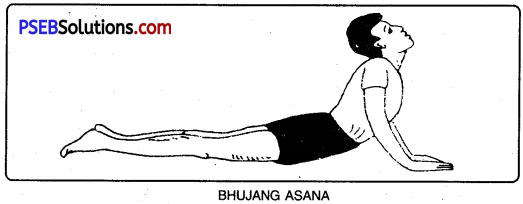
Advantages:
- Bhujangasana increases the digestive power.
- It helps get ride of the diseases of liver and spleen.
- It strengthens vertebral column and muscles.
- It helps in the removal of constipation.
- It helps the bulge of the belly go in.
- It makes the lungs strong.
![]()
Question 4.
Discuss the techniques of Garur Asana and Tar Asana. Describe their advantages.
Answer:
Position of Garur Asana:
The position of Garur Asana is standing on both feet-
Techniques:
- While standing straight, lift the left leg and encircle the other leg.L
- Left thigh will come over right thigh. The part of the lower leg will cover right side of the lower leg.
- Put the body weight on one foot.
- Encircle left arm to the right arm and left.
- Both palm and come to the position of Namaskar.
- Then bend the left leg and bring the body in sitting position. In this way all nerves of the body will get stretched. Again straighten up the body and come to the position of Attention.
- Now change your legs and hands and repeat the same. Garur asana should be performed on each leg from one minutes to five minutes.
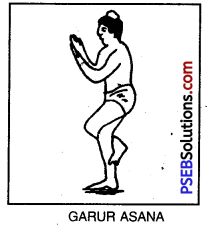
Advantages of Garur Asana:
- It strengthens all parts of the body.
- Body becomes healthy.
- It prevents the disease of Hernia.
- Legs become strong.
- One feels fresh and light.
- Circulation of blood increases.
- Man remains healthy and away from so many diseases.
1. Tar Asana:
In this asana the trunk is pulled upwards while in the standing position. The position of tar asana is like the Tar tree.
Technique of Tar Asana. Stand up, join the heels and toes of both the feet and lift the arms straight upward. Let the fingers of one hand cross those of the other hand. The wrists should be upward and the sight in front. Breathe in fully. Raise the heels and put the whole body weight on toes. Pull the body upwards. After sometime, breathe out and lower the body. Repeat this action 10-15 times.
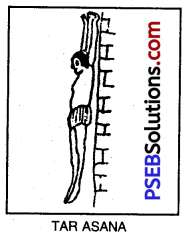
Advantages of Tar Asana:
- It reduces obesity of the body.
- It raises the stature
- It removes constipation.
- It prevents the diseases of the intestines.
- It serves to cleanse the bowels if it is done after taking cold water everyday.
Question 5.
What is the technique of Shirsh Asana ? Discuss its advantages. What precaution would you take while performing Shirsh Asana?
Answer:
![]()
Shirsh Asana:
Position. Bring your head down and keep legs upward.
Technique-
- Put blanket or towel on the floor and sit down on your knees.
- The fingers of both hands should be tightly interlocked. Put both hands on blanket.
- Put your head between both hand in such a way that thumb of the hand may press back part of your head.
- Bring both legs inside and put your thumb and legs straight upward.
- Lift the feet gradually. Firstly straight one leg and another.
- Try to keep your body in a straight line.
- Put your body weight on head and both arms equally.
- You can take help of the wall or your team-mates.
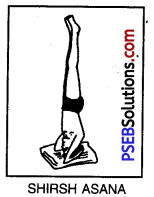
Advantages:
- Increases apettite.
- Make a person slim.
- Live and spleen become more active.
- It removes all diseases concerning primary track.
- Piles are cured.
- By doing regular practice of Shirsh Asana, mental diseases are cured.
Precautions:
- When eyes become red, Asana should be stopped.
- On feeling giddiness don’t do Shirsh Asana.
- Shirsh Asana should be stopped while feeling too much air in the ears.
- This asana should not be performed when inhalation becomes difficult.
- When body do not bear the weight.
- On shivering arms and legs.
- While feeling uneasiness. Shirsh Asana may not be performed.
- Shirsh Asana should be performed all alone.
- Take assistance when you feel necessity.
- Shirsh Asana can be performed from one minute to five minutes. More time would be harmful.
![]()
Question 6.
Describe the technique and advantages of Vajur Asana.
Answer:
Vajur Asana:
Position. Sitting on legs while keeping his feet behind.
Technique-
- Put on knees under your hip and sit down while facing the feet upper side.
- The thumb of the feet should touch each other.
- Both the knees may touch each other back and waist must be in a straight line.
- Put both hands on the both thighs.
- Breathing may be long.
- Vajur Asana may be performed daily from three minutes to twenty minutes.
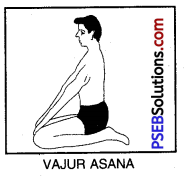
Advantages:
- Body becomes more active.
- Remove the fats of the body.
- Body becomes healthy.
- Muscles get strengthened.
- It helps to get rid of Night fall.
- It removes the pain of feet and legs.
- Mind becomes cool.
- Person becomes carefree.
- It cures diabetes.
- It improves digestion.
Question 7.
What are the eight components of Yoga according to Patanjali Rishi? Discuss in brief.
Answer:
According to Rishi Patanjali, there are eight stages or components of Yoga. They are follows:
- Yama, Forbearance
- Niyama, Observance
- Asana, Posture
- Pranayama, Regulation of Breathing
- Pratyahara, Abstraction
- Dharana, Concentration
- Dhyana, Meditation
- Samadhi, Trance
The first five components or stages out of the above-mentioned eight stages are connected with external Yogic exercises, and the remaining three are related to internal Yogic exercises. All these stages have been further divided as follows:
1. Yama:
Forbearance. It has the following five components:
- Ahimsa (Non-violence)
- Satya (Truth)
- Astey (Conquest of the senses of mind)
- Aprigraha (Non-receiving)
- Brahamcharya (Celibacy)
2. Niyama:
Observance: These two have the following five stages of components :
- Shauch (Obeying the call of nature)
- Tapa (Penance)
- Santosh (Contentment)
- Savadhyaye (Self-study)
- Ishwar Paridhan (God-consciousness).
3. Asana:
Posture The number of Asanas is as much as the number of birds. Asanas should be performed according to the capacity of the body. They should be done by exhaling air through breathing, stopping breath and re-Breathing everyday.
4. Pranayama:
Regulation of Breathing. Pranayama is a part of meditation. It has the following three parts:
- Purak (Inhalation)
- Rechak (Exhalation)
- Kumbhak (Holding of Breath): Holding breath and exhalation are called Pranayama (Regulation of breathing).
5. Pratyahara: Abstraction. Pratyahara means detachment of mind from all the vgorldly pleasures and comforts.
6. Dharana: Concentration Dharanameans exercising control over our organs But it is very difficult to practise it.
7. Dhyana:
Meditation. When a person gains control over mind the state of Dhyana sets in. In this state, body and mind become like the flow of the river in which the currents of water have no effect at all.
8. Smadhi Trance:
It is the state of mind which starts with Dharana and ends with Samadhi. All these states have deep connection among them.The science of Yoga is a valuable contribution of India to the world. Yoga is gaining popularity at home and abroad. All the doctors and teachers of Physical Education acknowledge its utility. Yogic exercises are completely scientific in nature and in accordance with the structure of the body.
![]()
Question 8.
Discuss the main principles of Yoga
Answer:
Main Principles of Yoga:
There are some principles which one must observe while doing Yoga. An account of these principles is given below:
1. Yoga Asanas should be performed in the morning after the practitioner eases himself. It is better to perform Yoga Asanas after having a bath. After taking bath body feels light and flexible and Asanas get performed very easily. Asanas can, of course, be done on empty stomach in the evening, too.
2. The place of Asanas should be clean and peaceful. It is desirable if Asanas are performed in a green park or garden.
3. The place where Asanas are to be performed should be even. Asanas should be performed on a mat so that one’s concentration is not disturbed by gravitational pull of the earth or by anything else.
4. One should not indulge in talks while performing Asanas. One should concentrate on one’s breathing and on the organ on which pressure is felt. The more one gets concentrated, the more shall be the benefit of the Asanas performed. Perform Shavasana before doing other Asanas to make body, mind and breath calm and poised.
5. Yogic exercises are slow and non-aggressive. They should never be performed with jerks. Each Asana should be performed slowly by making the body alert and tense. Then the body should be kept in a relaxed state after some time. The second Asana should be performed when breathing becomes normal.
6. Increase the duration of the Yoga Asanas slowly. Practise daily to reach the optimum level of an Asana. The body will become flexible slowly.
7. One should put on minimum clothes while doing Asanas,
keeping in view the needs of the season, of course. .
8. The Yoga Asanas can be performed by persons of all ages, children, old men, men or women. Persons from 10 to 80 or 85 years of age can perform Yoga Asanas. But Asanas should be performed systematically.
9. The person who performs Asanas should take light food. Food should be easily digestible, fresh and ‘Satwik’. Lighter the food, the more will be the efficiency of the Yogic practitioner.
10. A person suffering from some acute disease should not perform Asanas or Pranayam.
11. Don’t perform many Asanas in the beginning. Every Asana should be done slowly by keeping the eyes closed. Sarvangasana and Shishasana can be slowly performed upto 10 minutes. Don’t come back too soon from the initial stage to the last.
12. The order of the Asanas should be so arranged that one should be able to perform the counter-pose of the Asana performed. For example, Paschimotanasana followed by Konasana, its counter-pose, and Sarvangasana followed by Matsyasana, its counter-pose.
13. Shavasana must be performed after the completion of Yoga Asanas. One can have the benefit of Asanas only if one allows the body rest and relaxation by doing shavasana. Shavasana is a complete Asana in itself. It generates great power in the body.
14. Don’t eat anything at least for half an hour after completing the programme of Asanas or Pranayam.
15. Practise stopping breathing after exhaling air.
16. Yoga Asanas should be performed daily.
![]()
Question. 9.
Yoga is the means of Health. Describe.“Yoga is the means of uniting soul with God.” How?
Answer:
“Yoga is the means of Health”
The prominent aim of Yoga is to keep man strong and energetic physically and mentally, and to increase his sensibility and con- sciouness. The chief qualities of Yoga are as follows :
- Man’s basic faculties of body and mind develop by means of Yoga. Lungs get enough air through the exercise of pranayama, as a result of which they get exercised and energised, and get rid of many ailments.
- Man’s body remains completely healthy through Yoga. Dhoti and Basti help in cleaning liver and intestines respectively. Clean body, we know, always remains healthy.
- Body gets strengthened with Yoga.
- By doing Yogic Asanas the organs of body become flexible. For example Hal-Asana and Dhanur-Asana help in increasing the flexibility of the backbone.
- All body systems begin to function properly with Yogic exercises.
- Yogic exercises keep human body in good and correct posture, as a result of which man’s personality improves. For example, by doing Brikh-Asana, knees do not strike, and by doing Padam-Asana, one’s belly does not protrude and shoulders do not develop hump.
- Mental discipline develops by doing Yoga. By doing Yama and
Niyama, one is enabled to exercise control on one’s undesirable emotions and vices. - Many ailments get removed by performing Yoga Asanas correctly. Vajar-Asana and Mastainder-Asana help in the removal of diabetes. Similarly, Pranayama keeps the lungs free from ailments.
- Yoga Asanas help in removing physical and mental fatigue. Shavasana helps in the removal of tiredness.
- Man’s intelligence and memory increase as a result of
performing Yoga Asanas. Shirsh-Asana proves to be very useful in this respect. - Yogic exercises develop a sort of rhythm in man’s body.
- Yogic Asanas are the best means of attaining peace and balance of mind.
